All about preparing the soil for cucumbers in spring and autumn
When growing cucumbers, it is important not only to apply the correct agrotechnical techniques, but also to place the seedlings in suitable soil. As part of the preparation of a greenhouse or open beds for planting cucumbers, it is necessary to determine the composition and acidity of the soil and, if necessary, improve it by introducing mineral or organic fertilizers.
Soil types in Russia
Not all types of soil that can be found in the country are suitable for growing cucumbers.
- The most acidic are salt marshes, salt licks and carbonate soils. The pH parameters are in the range of 7.5-9.5. In summer, they warm up to 25⁰C in the upper layer. Such soils are practically unsuitable for growing cucumbers; in order to normalize them, it is necessary to enrich the upper layer with humus, release salts, and get rid of alkali.
- The optimum acidity is in such types of soil as chestnut, chernozems, gray soils. Their acidity parameters are in the range of 6.5–7.5 pH. In summer, they warm up to 15⁰C, practically do not require composition correction, are suitable for cucumbers and almost all other garden crops.
- In permafrost-taiga soils, acidity indicators are very different and depend on the region, fluctuating within 4.5–7 pH. They do not warm up due to low temperatures, they are not suitable for cucumbers. Sometimes they are used in greenhouses and hotbeds - in this case, lime is added to them.
- Gray forest soil has a pH range of 4.5 to 6.5. It warms up well, sometimes it needs minimal liming.
- Sod-podzolic, podzolic soil options are not suitable. They have low acidity - in the range of 4.5–5.6 pH, they warm up to only 8–10⁰С, they always need deoxidation, shelter to raise the temperature and additional feeding with humus.
- Swamp-podzolic, peat-podzolic soils are not suitable for cucumbers. They are slightly acidic, the pH level is in the range of 3-5, the earth is very cold at night and overheats during the day. Measures against temperature fluctuations and additional liming are required.
Cucumbers can be grown on neutral or slightly acidic soil. In the latter case, additional lime is added to normalize the composition.
Ideal soil parameters
Cucumbers grow wild in Asia, preferring subtropical forests. The soils there are light, saturated with moisture, a large volume of fallen leaves and organic residues emit carbon dioxide during decay, soils with neutral acidity or slightly alkaline.
Consider the required soil parameters for 6 main points.
- Structure. Cucumber prefers light, moisture and breathable loose soil. Optimal for this are medium and light loams, which are characterized by a high degree of aeration, are able to evenly distribute and retain water inside.
- Humidity level. The optimal range is 75% to 85%. You can check the moisture content of the soil manually in a simple way: take a handful of soil from the top layer in your hand and squeeze it firmly. If drops of water remain on the palm, it means that the soil moisture is above 80%. If you get a strong lump with visible fingerprints, the humidity is within 70-75%. If it is not possible to form a lump, the soil crumbles, the humidity is below 60%.
- Temperature. Cucumbers belong to early ripening crops, they begin to bear fruit early, therefore, for planting seedlings or planting seeds, the earth must be warm - at least 18 ° C. If the temperature drops to 15 ° C and below, the development of the root system stops.
- Acidity. Cucumbers do not tolerate soil acidification; they prefer soils with a pH level in the range from 6.2 to 6.8.
- Humus content. It is optimal if it is concentrated in the upper layers, which will give the plant the necessary conditions for growth and development. Cucumbers also prefer high microbiological activity.
- Nutrient content. The most important minerals are nitrogen, magnesium, potassium and phosphorus. With a lack of nitrogen, the growth of the aerial part and the root system stops. If there is not enough potassium, the plant weakens, more easily exposed to diseases and frosts. Phosphorus deficiency reduces the yield. When there is not enough magnesium, the leaves can turn yellow and fall off, the growth of fruits slows down.
The root system of cucumbers is undeveloped, superficial - lower than 30 cm deep into the soil, does not penetrate. Therefore, the groundwater level does not matter. Watering, top dressing, loosening should be carried out only in the upper layer.
How to determine acidity?
There are several methods to determine the acidity level without special litmus papers and instruments. The simplest of them is based on indicator plants:
- if horsetail, blueberries, moss, horse sorrel predominate on the site - acidity is high, lime must be added;
- wild rosemary, mint, lingonberry, bearberry - medium acidity, deoxidation is necessary;
- sedge, shrimp, bells - indicators of soil suitable for cucumbers, weak acidity or with neutral PH;
- coltsfoot, chamomile, clover, thistle, nettle, shepherd's purse, yarrow - neutral indicators of acidity, the land is suitable for growing cucumbers;
- wormwood, alfalfa, sedge - slightly alkaline soil, suitable for cucumbers.
Another simple method can be used to determine the type and, accordingly, the acidity of the soil. Take a handful of earth, moisten it so that the water does not flow out. Knead well and make a tight lump. Then roll a string about 3 mm in diameter out of the ground, roll it into a ring and track the reaction:
- sandy loam - the earth quickly crumbles;
- medium loam - the lace is dense, uniform, breaks when trying to fold into a circle;
- light loam - it is not possible to twist a tight lace;
- heavy loam - it turns out to form a ring, but cracks appear on it;
- alumina - the ring is dense, solid, without cracks.
You can also determine the acidity with table vinegar. To do this, put a small handful of soil in a glass container, pour vinegar. A bubble and hiss reaction occurs if the soil is alkaline or neutral. If there is no reaction, then the soil is acidic and needs liming (dolomite flour, lime).
What soil do cucumbers like - acidic or alkaline?
Insofar as cucumbers prefer light, loose nutritious non-acidic soils, it is important to properly optimize the composition of the soil for cucumbers in the spring.
- Dense clayey soils are of little use for growing cucumbers, but even they can be brought into proper condition. It is necessary to add disintegrants and humus-forming substances. These include brick chips, sand, horse manure, rabbits, droppings, compost, rotted leaves.
- Light loams practically do not need preparation. They are loose and highly aerated. Can be enriched with manure at the rate of up to 6 kg per 1 m2 plot.
- Sandy loam are light, they pass well, but do not retain moisture, are easy to process, and are distinguished by a rapid transformation of organic matter. Suitable for cucumbers, but it must be borne in mind that the top layer cools quickly at night and minerals are washed out from such light soils. You can solve this problem by adding compost or manure in autumn at the rate of 10 kg per 1 m2.
- Sandstones are not suitable for growing cucumbers, since they are not able to retain moisture, and with it minerals. In addition, such soils instantly warm up and cool at night. You can improve the soil with rotted manure or peat.A more costly and laborious method is clay. It consists in the fact that for each square meter of the plot, 2 buckets of powdered clay are introduced, then compost or manure is added, and dug up. The procedure is performed annually for at least 3 years.
- Peat-boggy soil is not suitable for cucumbers. It is distinguished by excessive fibrillation, moisture, organic matter practically does not decompose here, peat sours. You can also distinguish this type of soil from others by its color - it will be light-stormy. To optimize the composition, you first need to dry it, then make channels for water drainage. After that, 1 m2... the site is brought in half a bucket of sand, the same amount of powdered clay and about 1 kg of lime - depending on the level of acidity. After that, the site is dug to a depth of at least 20 cm.
In the greenhouse and in the open ground, the soil for cucumbers is prepared in the same way - they optimize the mechanical composition and acidity, determine and adjust the humidity, carry out mulching, add fertilizing and stimulate humus formation. In the open field, it may be necessary to additionally insulate the beds with black agrofibre or other materials that will keep the heat.
Soil preparation
Prepare the soil before planting seeds or seedlings. Outdoor and greenhouse activities are slightly different.
In the greenhouse
You can prepare the ground for planting as follows:
- High temperature and humidity in protected ground contributes to the development of fungal diseases, therefore fungicides or biological agents in the form of solutions and tablets are used for treatment - "Glyocladin", "Fitosporin".
- It is almost impossible to comply with the norms of crop rotation in greenhouse conditions, which is why it is recommended to completely replace the upper depleted layer of soil. If this is not possible, disinfection is advised - adding bleach, watering the soil with boiling water, 2% formalin solution. These products can be used to spray the soil, walls, floor, props, and treat with sulfur before planting.
If the cucumbers are regularly grown in the same garden, you can use green manure. They are sown immediately after harvesting; about a month later, a green mass grows, which is mowed and dropped onto one bayonet.
In the garden
In an open area, it is necessary to regularly change the place for seedlings of cucumbers so that they are in the same garden bed no earlier than after 4 years. Peas, cabbage and tomatoes are considered the optimal predecessors of the culture, pumpkin and eggplants are the worst.
For the garden bed, choose an illuminated place, closed from cold drafts. The site must be dug to a depth of about 20 cm. Then the garbage and tops are removed. In the open field, green manure can also be used to improve the composition.
It is necessary to prepare the ground since the fall, immediately after harvesting the fruits and harvesting organic residues from the site.

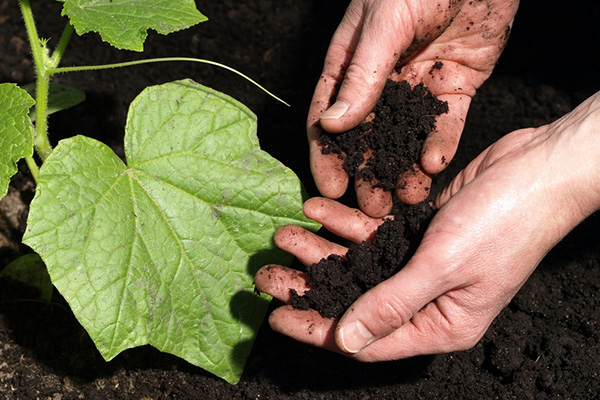
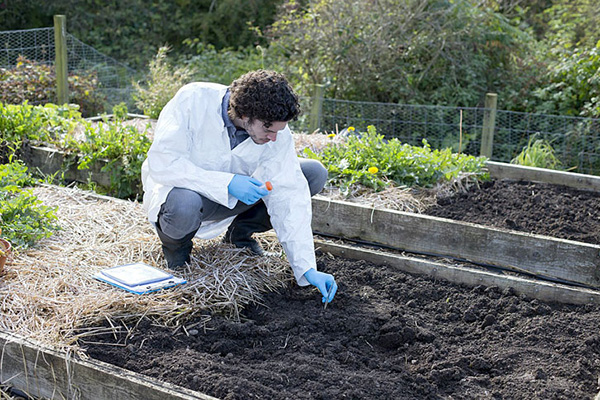
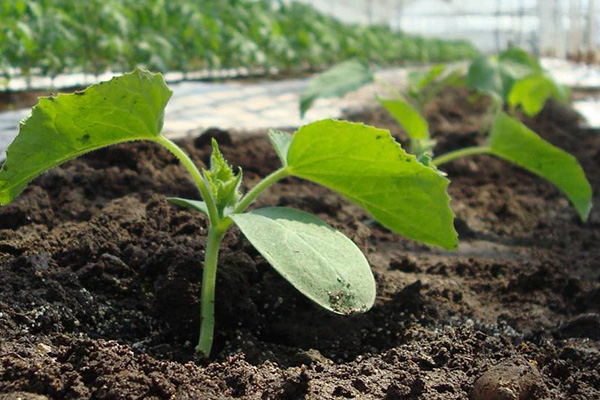

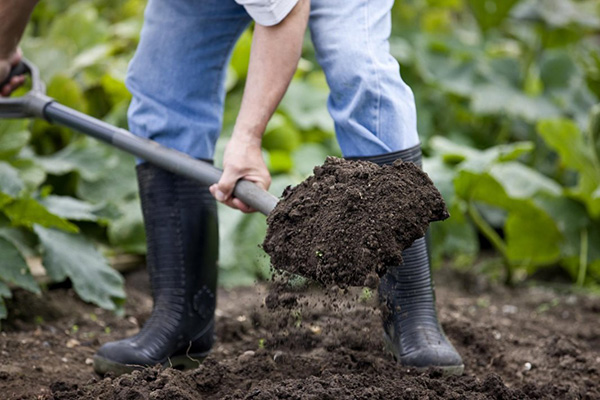
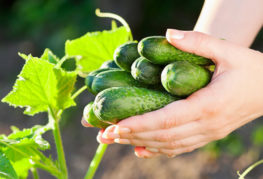
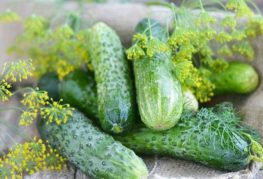
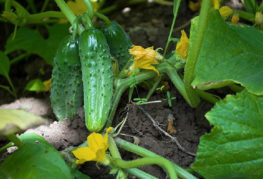
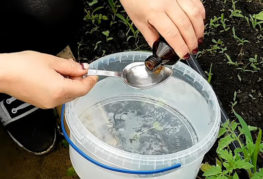
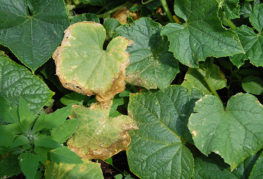
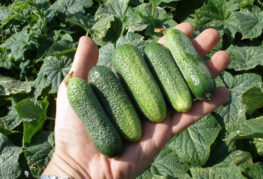
I read the beginning of the ARTICLE: The most acidic are salt marshes, salt licks and carbonate soils. The pH parameters are in the range of 7.5-9.5. Correct the mistake.